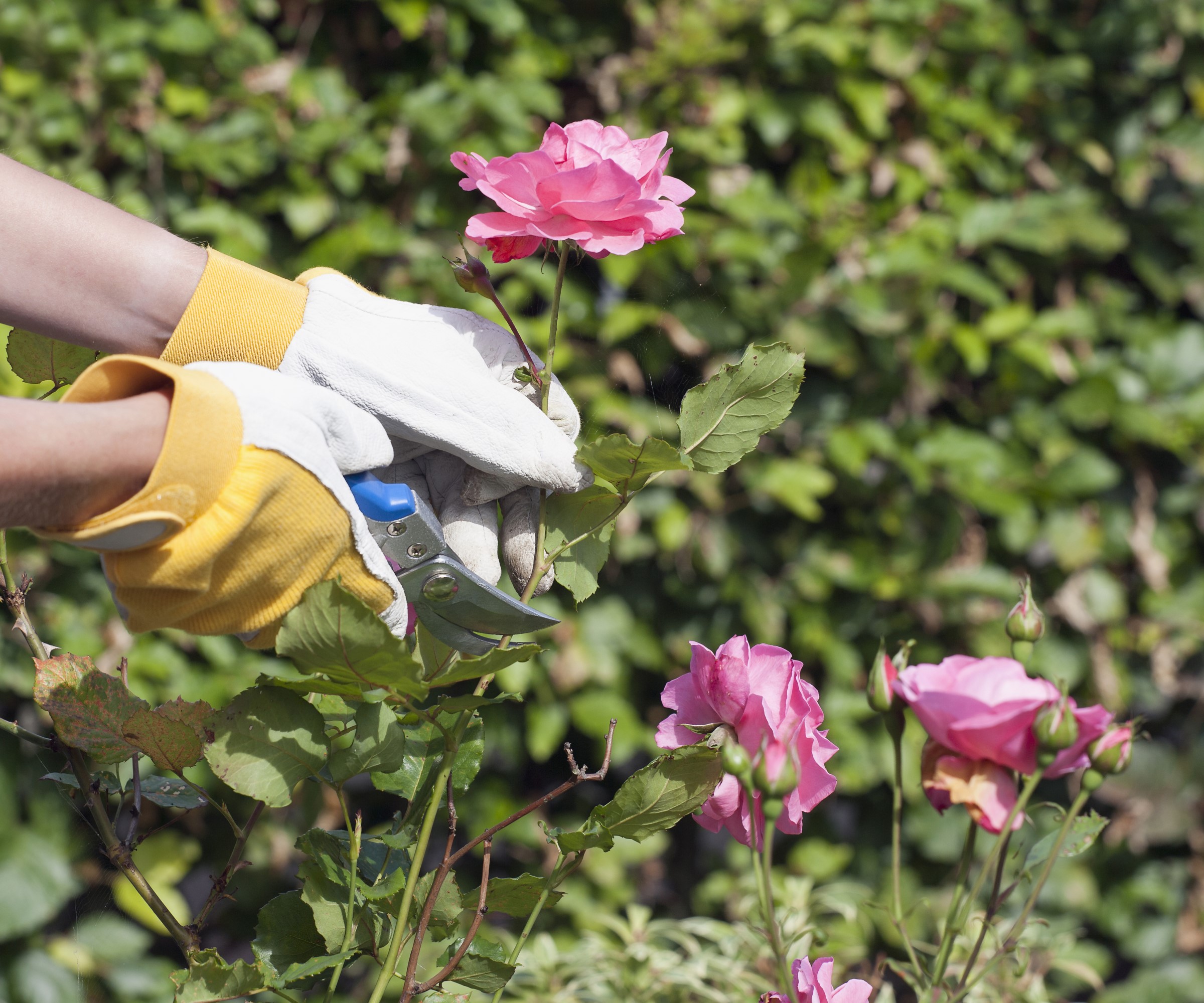When and how to prune Knock Out roses – know the signs that the time is right
Discover the simple pruning steps to follow for glorious and healthy Knock Out roses


Knock Out roses are easy-to-grow and low-maintenance rose shrubs that were bred to produce lots of blooms and be tough plants. While being simple to grow and maintain, they do need to be pruned every year to keep performing at their best.
These fast-growing shrub roses are available in a range of colors and are popular choices for people landscaping with roses, in part due to their ease and versatility.
Whether you have a dedicated rose garden, or you plant Knock Out roses among other plants and shrubs in a flower bed, they can look stunning for many months of the year.
As with growing and caring for any roses, annual pruning will keep the plant in shape, healthy, and producing fantastic displays of blooms year-after-year. To help you know when and how to prune Knock Out roses, we've got some expert tips from a renowned garden author and speaker.

Knock Out roses can be kept compact by pruning
Tools needed to prune a Knock Out rose bush
Pruning Knock Out roses is not a very difficult task to do and you do only need some common garden tools to complete it.
You want a pair of pruning shears, loppers for cutting thick branches, and a pair of thick gardening gloves to protect you from sharp thorns. All tools need to be sharp, to make clean cuts, and sanitized to prevent spreading rose diseases from bush-to-bush around the garden.

Work gloves that are made of high-quality grain cowhide and split cow leather. They are thick, puncture-resistant, and cut-resistant, while also being soft and flexible to help when pruning
When to prune Knock Out roses

Late winter or early spring is the ideal time to prune most roses
Pruning roses is an essential part of annual care to encourage the stimulation of new, highly productive growth. So, when do you prune Knock Out roses? As the shrubs bloom on new growth produced that season, pruning Knock Out roses in the spring encourages the production of that new wood and guarantees a fantastic display of blooms.
The ideal time to prune Knock Out roses actually comes in late winter or early spring, whenever you start to see the first signs of new growth in the year. C.L. Fornari, garden writer and speaker, recommends waiting till you see ‘new, red shoots start to form on the stems’. The sight of those new shoots should be an indicator that it is the perfect time to head out with the tools to trim.
The exact time those new shoots will start to show on your Knock Out roses will depend on your US hardiness zone, but it will be late winter or early spring and recognizing the signs for when to prune roses prevents you from making any rose pruning mistakes.
You can also lightly trim and cut back Knock Out roses during the summer months. Knock Out roses are bred to not need deadheading, as they are self-cleaning, however, removing spent flowers does have benefits in terms of the look and health of the shrub. However, you should stop pruning when it gets to late summer or early fall.

A red double Knock Out rose bush that produces rich, cherry red to hot pink blossoms that will continue to grow until the first hard frost of winter
How to prune Knock Out roses

Knock Out roses tend to grow to a height of 3-4 feet
When you are planning how to cut back Knock Out roses, it is important to do any trimming in a considered way. Take a moment prior to starting pruning to look at the shrub and determine what size and shape you are going for. Then you can don your thornproof gloves - a prerequisite for rose pruning - and start to trim.
‘The first step is to cut out anything that's dead,’ says. C.L. Fornari. ‘That's why you prune them when they have the new, red shoots... you'll clearly be able to see what is living and what is dead. Remove all the dead wood.’
After removing any dead wood, along with any damaged stems or those showing any signs of disease, the focus moves onto pruning out stems that are going in unwanted directions. This includes stems going into the center of the shrub and any weak or curved stems, all of which should be removed all the way back to where they join another stem.
The removal of all these unwanted stems will help to promote air and light circulation through the shrub, which can help to prevent diseases. C.L. then advises to ‘look at the base of the plant and identify the thickest, oldest, grayest stems’. She says: ‘Cut a third of them down to about four inches from the ground.
‘Only after all of that do you cut the remaining stems down in height. You can cut as little as 1/8th of the plant's total height to 1/3 of their total height in a normal pruning.’
It is at that final point of trimming the rest of the stems that you really do need to take the final size of the bush into consideration. Knock Out roses are vigorous growers and the shrub will tend to triple in size during the growing season.
So it is important to take into account how tall and wide it may grow in the months ahead - a failure to plan effectively could result in the shrub growing into other plants, or stems getting tall and risking snapping in winds.
But what if your shrub has not been pruned for many years and is in an unruly state, how far back can you prune Knock Out roses? In such a scenario, C.L. Fornari recommends some ‘rejuvenation pruning’ that may sound brutal - but will benefit the plant. She says: ‘That's where you cut the entire plant down to 6 to 8 inches tall. The plants recover fairly quickly from this and you'll have all new canes again.’

C.L. Fornari is the author of eight books, including Coffee for Roses and The Cocktail Hour Garden. She’s a professional speaker, the host of GardenLine on WXTK, and co-host of the Plantrama podcast. She is a frequent speaker to groups nationwide, and has worked for a family-owned independent garden center for 25 years. C.L. grows vegetables, flowers, shrubs, trees and numerous other plants at Poison Ivy Acres on Cape Cod.
FAQs
Should I prune Knock Out roses in fall?
It would be a pruning mistake to trim your Knock Out roses in fall. The danger of pruning so late in the season, especially in colder climates, comes from the fact that trimming will encourage a flush of new growth. These new stems will not be able to cope with the incoming colds and will easily get damaged by frosts and snow. This can leave the shrub at an increased risk of pests and diseases.
Can you prune Knock Out roses in summer?
Knock Out roses can benefit from some light pruning throughout the summer. Though the shrubs are bred to be self-cleaning, removing spent flowers after the first period of blooms can help encourage the development of new buds and reward you with a longer season of flowering.
It is beneficial to remove spent flower blooms singularly, or trim clusters completely once they have all flowered. In addition, if you identify any damaged stems, or ones showing signs of disease, you can also prune these off the shrub during the summer.
If you want to plant more roses as part of your backyard ideas, they will come either container-grown or bare root. Those grown in containers can be planted at any time of the year, while bare root roses tend to be available to plant from fall through to early spring.
Sign up to the Homes & Gardens newsletter
Design expertise in your inbox – from inspiring decorating ideas and beautiful celebrity homes to practical gardening advice and shopping round-ups.

Drew’s passion for gardening started with growing vegetables and salad in raised beds in a small urban terrace garden. He has worked as a professional gardener in historic gardens and specialises in growing vegetables, fruit, herbs, and cut flowers as a kitchen gardener. That passion for growing extends to being an allotmenteer, garden blogger, and producing how-to gardening guides for websites. Drew was shortlisted for the New Talent of the Year award at the 2023 Garden Media Guild Awards.
-
 Plants never to grow next to fruit trees
Plants never to grow next to fruit treesExpert advice on which plants to keep away from fruit trees to encourage a healthy harvest
By Jacky Parker Published
-
 Martha Stewart's tips for arranging daffodils are unbelievably simple and effective – it's the only flower advice you need this springtime
Martha Stewart's tips for arranging daffodils are unbelievably simple and effective – it's the only flower advice you need this springtimeMartha shows us that we can create gorgeous bouquets of this seasonal flower by simply trimming the stems and placing them in specific vases
By Hannah Ziegler Published